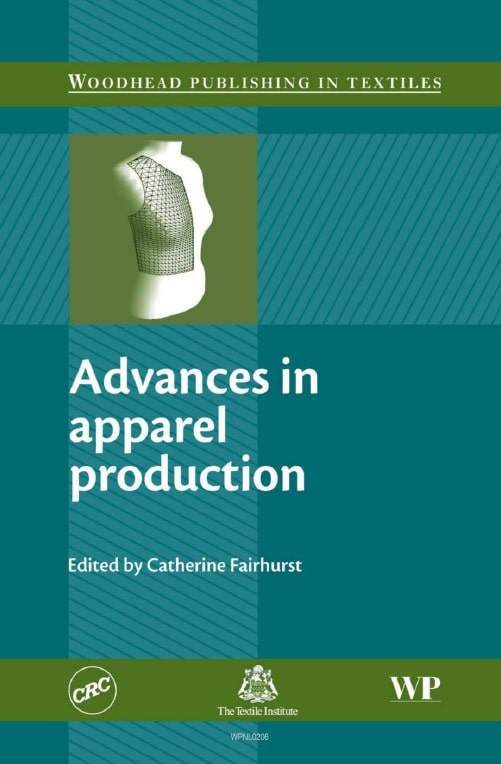
Contents
Contributor contact details x
Woodhead Publishing in Textiles xiii
Introduction 1
Part I Advances in apparel design
1 Measuring and predicting fabric and garment drape 7
L. HUNTER, CSIR and Nelson Mandela Metropolitan University,
South Africa and J. FAN, The Hong Kong Polytechnic
University, Hong Kong
1.1 Introduction 7
1.2 Measurement of drape 8
1.3 Empirical prediction of drape 13
1.4 Modelling fabric and garment drape 17
1.5 Drape models in computer-aided design and Internet systems 20
1.6 Sources of further information and advice 21
1.7 Concluding remarks 21
1.8 References 22
2 Computer-aided colour matching of apparel fabric 26
E. ALHO, Datacolor, Switzerland
2.1 Introduction: principles and problems in maintaining colour integrity 26
2.2 Colour theory 30
2.3 Colour-measurement technology 34
2.4 Colour-matching technology 36
2.5 Colour communication and approval 39
2.6 Technological advances in matching colours 40
2.7 Computer-aided colour matching 41
2.8 Opportunities for the supplier 51
2.9 Opportunities for the fashion industry 54
2.10 Future trends 55
2.11 Sources of further information and advice 56
2.12 Bibliography 56
2.13 References 57
3 Computer-aided design for yarn 58
T. CASSIDY, University of Leeds, UK and S. GRISHANOV,
De Montfort University, UK
3.1 Introduction 58
3.2 Background 58
3.3 Early stages 59
3.4 Survey of the industrial process 63
3.5 Further development of YarnCAD 64
3.6 Future trends 70
3.7 Conclusion 71
3.8 Acknowledgements 71
3.9 References 72
4 Improving apparel sizing and fit 73
R. B. OTIENO, Manchester Metropolitan University, UK
4.1 Introduction 73
4.2 Key issues affecting apparel sizing and fit 74
4.3 Importance and development of size charts 82
4.4 Application of technological advancements 85
4.5 Application 88
4.6 Future trends 89
4.7 Sources of further information and advice 90
4.8 References 90
5 Three-dimensional body scanning to improve fit 94
C. L. ISTOOK, North Carolina State University, USA
5.1 Introduction 94
5.2 Types of body scanning technology 95
5.3 Light-based systems 97
5.4 Laser-based systems 101
5.5 Microwave-based systems 103
5.6 Advantages of body scanning technology 103
5.7 Disadvantages of body scanning technology 105
5.8 Uses of body scanning in the apparel industry 107
5.9 Conclusion 113
5.10 Sources of further information and advice 113
5.11 Acknowledgments 114
5.12 References 114
6 Computer-aided garment design using three-dimensional body models 117
B. K. HINDS and J. MCCARTNEY, Queen’s University Belfast, UK
6.1 Introduction 117
6.2 Related work 118
6.3 User interface for three-dimensional design 119
6.4 Creating garment panels 123
6.5 Panel flattening and texture rendering 131
6.6 Full system implementation 135
6.7 Future work 136
6.8 References 138
7 Computerised pattern making in garment production 140
T. BOND, Manchester Metropolitan University, UK
7.1 Introduction 140
7.2 Principles of pattern making 140
7.3 Garment balance 142
7.4 Size charts 142
7.5 Pattern grading 142
7.6 Computerised made-to-measure systems 143
7.7 Main technological advances in pattern making 144
7.8 Material utilisation 151
7.9 Applications/developments within computer-aided apparel systems 151
7.10 Future trends 152
7.11 Sources of further information and advice 153
7.12 Bibliography 153
Part II Advances in apparel production
8 Advances in apparel product development 157
D. TYLER, Manchester Metropolitan University, UK
8.1 Introduction 157
8.2 Industrial change 157
8.3 Process model for clothing product development 158
8.4 Models of new product development 161
8.5 Product development tools and application areas 165
8.6 Product lifetime management (PLM) 167
8.7 Demand-led new product development 170
8.8 Future trends 175
8.9 Sources of further information and advice 176
8.10 References 176
9 Developments in apparel knitting technology 178
J. POWER, Manchester Metropolitan University, UK
9.1 Introduction 178
9.2 Principles of knitting 179
9.3 Weft knitting technology 183
9.4 Shaping technologies 186
9.5 Post-knitting – construction methods 190
9.6 Weft knitwear in fashion applications 191
9.7 Trends in weft knitting 193
9.8 Sources of further information and advice 195
9.9 References 196
10 Technological advances in sewing garments 197
S. G. HAYES and J. MCLOUGHLIN, Manchester Metropolitan
University, UK
10.1 Introduction 197
10.2 The history of sewing 198
10.3 Examples of sewn products 198
10.4 Development of the industrial sewing machine 199
10.5 Advances in sewing-needle design 205
10.6 Advances in sewing-thread technology 209
10.7 Advances in sewing-machine automation 214
10.8 Semi-automated sewing equipment 215
10.9 Machines using computer numerical control 218
10.10 Future trends in clothing technology 219
11 Digital printing of textiles for improved apparel production 222
J. R. CAMPBELL, Glasgow School of Art, UK
11.1 Introduction 222
11.2 Main advances in digital printing technology 224
11.3 Design potential and limitations of digital textile printing 231
11.4 How digital textile printing can enhance production in the apparel industry 236
11.5 Applications 237
11.6 Future trends 246
11.7 Sources of further information and advice 247
11.8 References 248
12 Developments in pressing technology for garment finishing 250
W. R. KENNON, The University of Manchester, UK
12.1 Introduction 250
12.2 The pressing process 251
12.3 Pressing with pressure 252
12.4 Pressing without pressure 258
12.5 Crease-resistant finishes 263
12.6 Permanent creasing 263
12.7 Future trends 263
12.8 References 264
13 Automated fabric inspection 266
J. MCLOUGHLIN and S. G. HAYES, Manchester Metropolitan University, UK
13.1 Introduction 266
13.2 The principles of textile inspection 266
13.3 The Kawabata Evaluation System 271
13.4 Fabric Assurance by Simple Testing 276
13.5 Automating the results of objective reporting and analysis (the Kawabata evaluation system) 278
13.6 Development of the main analysis form 279
13.7 Conclusions 298
13.8 References 301
Index 304
